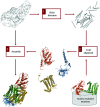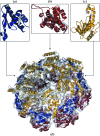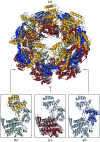EMatch: an efficient method for aligning atomic resolution subunits into intermediate-resolution cryo-EM maps of large macromolecular assemblies
- PMID: 17164525
- PMCID: PMC2483490
- DOI: 10.1107/S0907444906041059
EMatch: an efficient method for aligning atomic resolution subunits into intermediate-resolution cryo-EM maps of large macromolecular assemblies
Abstract
Structural analysis of biological machines is essential for inferring their function and mechanism. Nevertheless, owing to their large size and instability, deciphering the atomic structure of macromolecular assemblies is still considered as a challenging task that cannot keep up with the rapid advances in the protein-identification process. In contrast, structural data at lower resolution is becoming more and more available owing to recent advances in cryo-electron microscopy (cryo-EM) techniques. Once a cryo-EM map is acquired, one of the basic questions asked is what are the folds of the components in the assembly and what is their configuration. Here, a novel knowledge-based computational method, named EMatch, towards tackling this task for cryo-EM maps at 6-10 A resolution is presented. The method recognizes and locates possible atomic resolution structural homologues of protein domains in the assembly. The strengths of EMatch are demonstrated on a cryo-EM map of native GroEL at 6 A resolution.
Figures




Similar articles
-
EMatch: discovery of high resolution structural homologues of protein domains in intermediate resolution cryo-EM maps.IEEE/ACM Trans Comput Biol Bioinform. 2007 Jan-Mar;4(1):28-39. doi: 10.1109/TCBB.2007.1003. IEEE/ACM Trans Comput Biol Bioinform. 2007. PMID: 17277411
-
FOLD-EM: automated fold recognition in medium- and low-resolution (4-15 Å) electron density maps.Bioinformatics. 2012 Dec 15;28(24):3265-73. doi: 10.1093/bioinformatics/bts616. Epub 2012 Nov 6. Bioinformatics. 2012. PMID: 23131460 Free PMC article.
-
Cryo-EM of macromolecular assemblies at near-atomic resolution.Nat Protoc. 2010 Sep;5(10):1697-708. doi: 10.1038/nprot.2010.126. Epub 2010 Sep 30. Nat Protoc. 2010. PMID: 20885381 Free PMC article.
-
Current approaches for the fitting and refinement of atomic models into cryo-EM maps using CCP-EM.Acta Crystallogr D Struct Biol. 2018 Jun 1;74(Pt 6):492-505. doi: 10.1107/S2059798318007313. Epub 2018 May 30. Acta Crystallogr D Struct Biol. 2018. PMID: 29872001 Free PMC article. Review.
-
Cryo electron microscopy to determine the structure of macromolecular complexes.Methods. 2016 Feb 15;95:78-85. doi: 10.1016/j.ymeth.2015.11.023. Epub 2015 Nov 27. Methods. 2016. PMID: 26638773 Free PMC article. Review.
Cited by
-
IDSS: deformation invariant signatures for molecular shape comparison.BMC Bioinformatics. 2009 May 22;10:157. doi: 10.1186/1471-2105-10-157. BMC Bioinformatics. 2009. PMID: 19463181 Free PMC article.
-
Combining efficient conformational sampling with a deformable elastic network model facilitates structure refinement at low resolution.Structure. 2007 Dec;15(12):1630-41. doi: 10.1016/j.str.2007.09.021. Structure. 2007. PMID: 18073112 Free PMC article.
-
Variability of Protein Structure Models from Electron Microscopy.Structure. 2017 Apr 4;25(4):592-602.e2. doi: 10.1016/j.str.2017.02.004. Epub 2017 Mar 2. Structure. 2017. PMID: 28262392 Free PMC article.
-
Computational methods for constructing protein structure models from 3D electron microscopy maps.J Struct Biol. 2013 Oct;184(1):93-102. doi: 10.1016/j.jsb.2013.06.008. Epub 2013 Jun 21. J Struct Biol. 2013. PMID: 23796504 Free PMC article.
-
Cryo-EM Data Are Superior to Contact and Interface Information in Integrative Modeling.Biophys J. 2016 Feb 23;110(4):785-97. doi: 10.1016/j.bpj.2015.12.038. Epub 2016 Feb 1. Biophys J. 2016. PMID: 26846888 Free PMC article.
References
-
- Alberts, B. (1998). Cell, 92, 291–294. - PubMed
-
- Baumeister, W. & Steven, A. C. (2000). Trends. Biochem. Sci.25, 624–631. - PubMed
-
- Braig, K., Adams, P. D. & Brünger, A. T. (1995). Nature Struct. Biol.2, 1083–1094. - PubMed
-
- Ceulemans, H. & Russell, R. B. (2004). J. Mol. Biol.338, 783–793. - PubMed
-
- Chacon, P. & Wriggers, W. (2002). J. Mol. Biol.317, 375–384. - PubMed
Publication types
MeSH terms
Substances
Grants and funding
LinkOut - more resources
Full Text Sources
Research Materials

